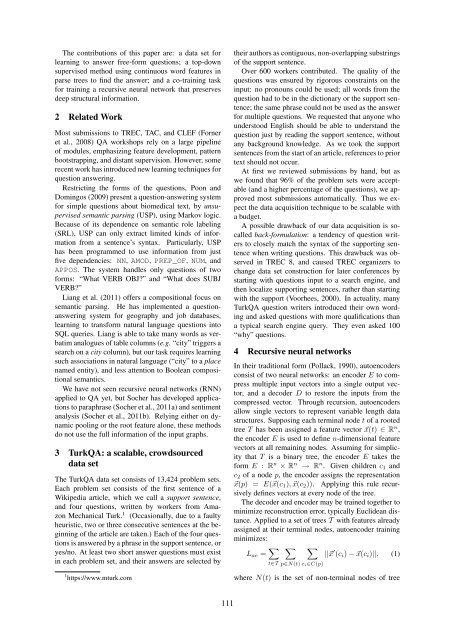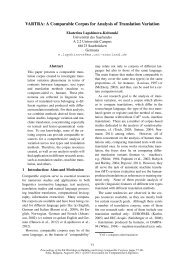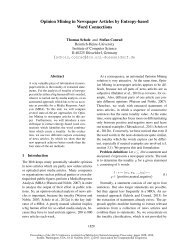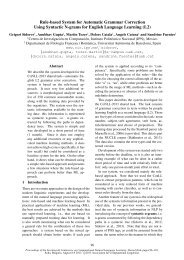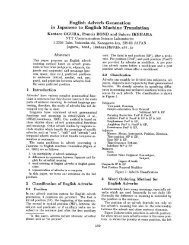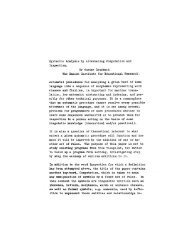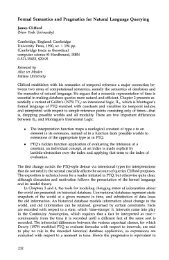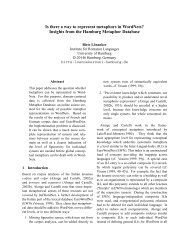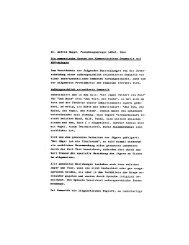Vector Space Semantic Parsing: A Framework for Compositional ...
Vector Space Semantic Parsing: A Framework for Compositional ...
Vector Space Semantic Parsing: A Framework for Compositional ...
You also want an ePaper? Increase the reach of your titles
YUMPU automatically turns print PDFs into web optimized ePapers that Google loves.
The contributions of this paper are: a data set <strong>for</strong><br />
learning to answer free-<strong>for</strong>m questions; a top-down<br />
supervised method using continuous word features in<br />
parse trees to find the answer; and a co-training task<br />
<strong>for</strong> training a recursive neural network that preserves<br />
deep structural in<strong>for</strong>mation.<br />
2 Related Work<br />
Most submissions to TREC, TAC, and CLEF (Forner<br />
et al., 2008) QA workshops rely on a large pipeline<br />
of modules, emphasizing feature development, pattern<br />
bootstrapping, and distant supervision. However, some<br />
recent work has introduced new learning techniques <strong>for</strong><br />
question answering.<br />
Restricting the <strong>for</strong>ms of the questions, Poon and<br />
Domingos (2009) present a question-answering system<br />
<strong>for</strong> simple questions about biomedical text, by unsupervised<br />
semantic parsing (USP), using Markov logic.<br />
Because of its dependence on semantic role labeling<br />
(SRL), USP can only extract limited kinds of in<strong>for</strong>mation<br />
from a sentence’s syntax. Particularly, USP<br />
has been programmed to use in<strong>for</strong>mation from just<br />
five dependencies: NN, AMOD, PREP_OF, NUM, and<br />
APPOS. The system handles only questions of two<br />
<strong>for</strong>ms: “What VERB OBJ?” and “What does SUBJ<br />
VERB?”<br />
Liang et al. (2011) offers a compositional focus on<br />
semantic parsing. He has implemented a questionanswering<br />
system <strong>for</strong> geography and job databases,<br />
learning to trans<strong>for</strong>m natural language questions into<br />
SQL queries. Liang is able to take many words as verbatim<br />
analogues of table columns (e.g. “city” triggers a<br />
search on a city column), but our task requires learning<br />
such associations in natural language (“city” to a place<br />
named entity), and less attention to Boolean compositional<br />
semantics.<br />
We have not seen recursive neural networks (RNN)<br />
applied to QA yet, but Socher has developed applications<br />
to paraphrase (Socher et al., 2011a) and sentiment<br />
analysis (Socher et al., 2011b). Relying either on dynamic<br />
pooling or the root feature alone, these methods<br />
do not use the full in<strong>for</strong>mation of the input graphs.<br />
3 TurkQA: a scalable, crowdsourced<br />
data set<br />
The TurkQA data set consists of 13,424 problem sets.<br />
Each problem set consists of the first sentence of a<br />
Wikipedia article, which we call a support sentence,<br />
and four questions, written by workers from Amazon<br />
Mechanical Turk. 1 (Occasionally, due to a faulty<br />
heuristic, two or three consecutive sentences at the beginning<br />
of the article are taken.) Each of the four questions<br />
is answered by a phrase in the support sentence, or<br />
yes/no. At least two short answer questions must exist<br />
in each problem set, and their answers are selected by<br />
1 https://www.mturk.com<br />
their authors as contiguous, non-overlapping substrings<br />
of the support sentence.<br />
Over 600 workers contributed. The quality of the<br />
questions was ensured by rigorous constraints on the<br />
input: no pronouns could be used; all words from the<br />
question had to be in the dictionary or the support sentence;<br />
the same phrase could not be used as the answer<br />
<strong>for</strong> multiple questions. We requested that anyone who<br />
understood English should be able to understand the<br />
question just by reading the support sentence, without<br />
any background knowledge. As we took the support<br />
sentences from the start of an article, references to prior<br />
text should not occur.<br />
At first we reviewed submissions by hand, but as<br />
we found that 96% of the problem sets were acceptable<br />
(and a higher percentage of the questions), we approved<br />
most submissions automatically. Thus we expect<br />
the data acquisition technique to be scalable with<br />
a budget.<br />
A possible drawback of our data acquisition is socalled<br />
back-<strong>for</strong>mulation: a tendency of question writers<br />
to closely match the syntax of the supporting sentence<br />
when writing questions. This drawback was observed<br />
in TREC 8, and caused TREC organizers to<br />
change data set construction <strong>for</strong> later conferences by<br />
starting with questions input to a search engine, and<br />
then localize supporting sentences, rather than starting<br />
with the support (Voorhees, 2000). In actuality, many<br />
TurkQA question writers introduced their own wording<br />
and asked questions with more qualifications than<br />
a typical search engine query. They even asked 100<br />
“why” questions.<br />
4 Recursive neural networks<br />
In their traditional <strong>for</strong>m (Pollack, 1990), autoencoders<br />
consist of two neural networks: an encoder E to compress<br />
multiple input vectors into a single output vector,<br />
and a decoder D to restore the inputs from the<br />
compressed vector. Through recursion, autoencoders<br />
allow single vectors to represent variable length data<br />
structures. Supposing each terminal node t of a rooted<br />
tree T has been assigned a feature vector ⃗x(t) ∈ R n ,<br />
the encoder E is used to define n-dimensional feature<br />
vectors at all remaining nodes. Assuming <strong>for</strong> simplicity<br />
that T is a binary tree, the encoder E takes the<br />
<strong>for</strong>m E : R n × R n → R n . Given children c 1 and<br />
c 2 of a node p, the encoder assigns the representation<br />
⃗x(p) = E(⃗x(c 1 ), ⃗x(c 2 )). Applying this rule recursively<br />
defines vectors at every node of the tree.<br />
The decoder and encoder may be trained together to<br />
minimize reconstruction error, typically Euclidean distance.<br />
Applied to a set of trees T with features already<br />
assigned at their terminal nodes, autoencoder training<br />
minimizes:<br />
L ae = ∑ ∑ ∑<br />
||⃗x ′ (c i ) − ⃗x(c i )||, (1)<br />
t∈T<br />
p∈N(t) c i∈C(p)<br />
where N(t) is the set of non-terminal nodes of tree<br />
111


